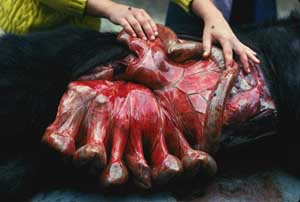|
|
 25 small intestine DHJanzen100935.jpg high resolution
|
|
| The ingesta moves from the stomach into the small intestine, here shown as it first poured out of the body cavity before it and the stomach were removed (in image DHJanzen100929.jpg above). This photograph emphasizes that the intestine is not just a long tube randomly tossed into the body cavity. Its loops and folds are organizedly distributed. And, the materials move down this long tube (see image DHJanzen100941.jpg) in response to the anatomy of these loops and folds. There are places of slow movement (at bends and close to the intestine wall) and fast movement (in the center of the tube and in relatively straight stretches. It is very likely that the intestinal microbial community is differentially distributed in the different flow types. There is also very likely to be a differential distribution of different kinds of microbes at different distances from the stomach, since the further from the stomach, the more time has passed with microbial communities extracting their particular kinds of nutrients. By the time the ingesta reaches the large intestine, essentially all the nutrients that are going to be extracted by the microbes and the bear have been removed. | ||
back to lecture slides
or skip to: